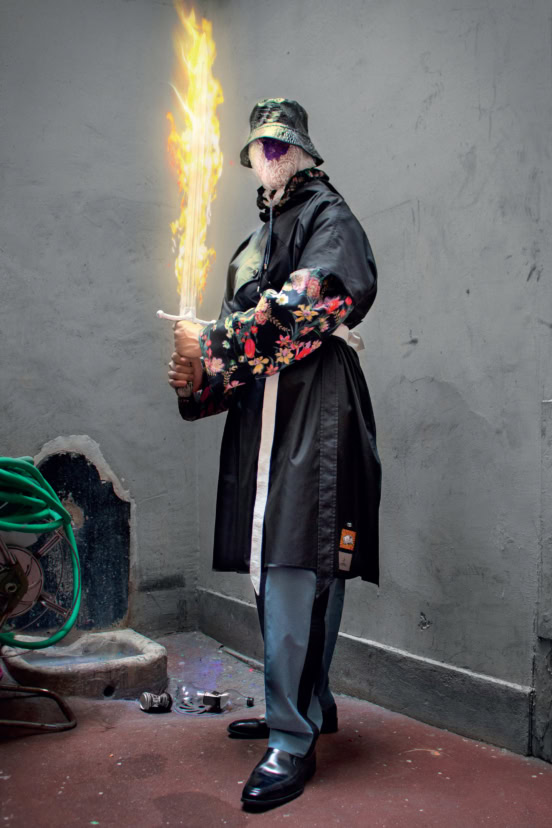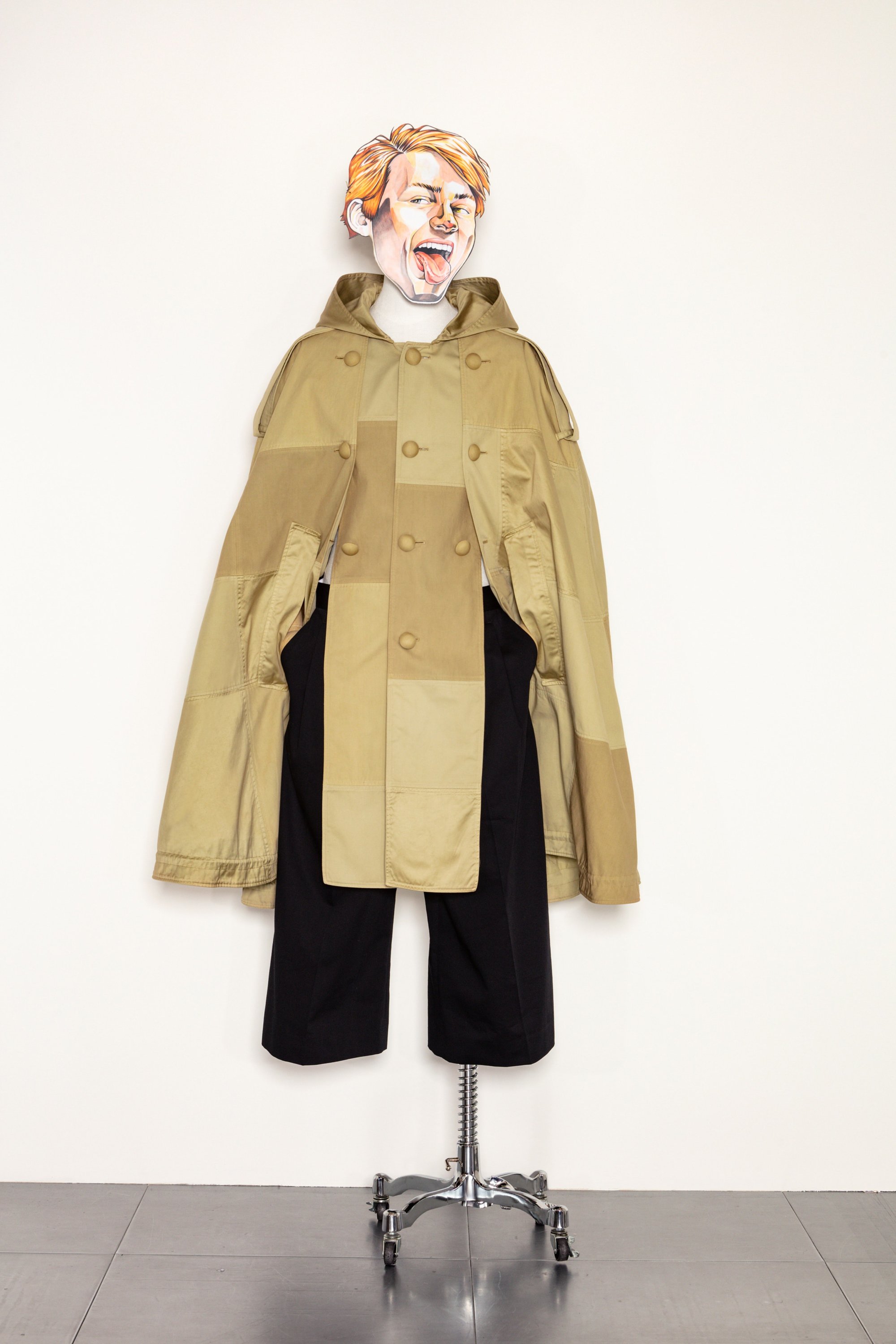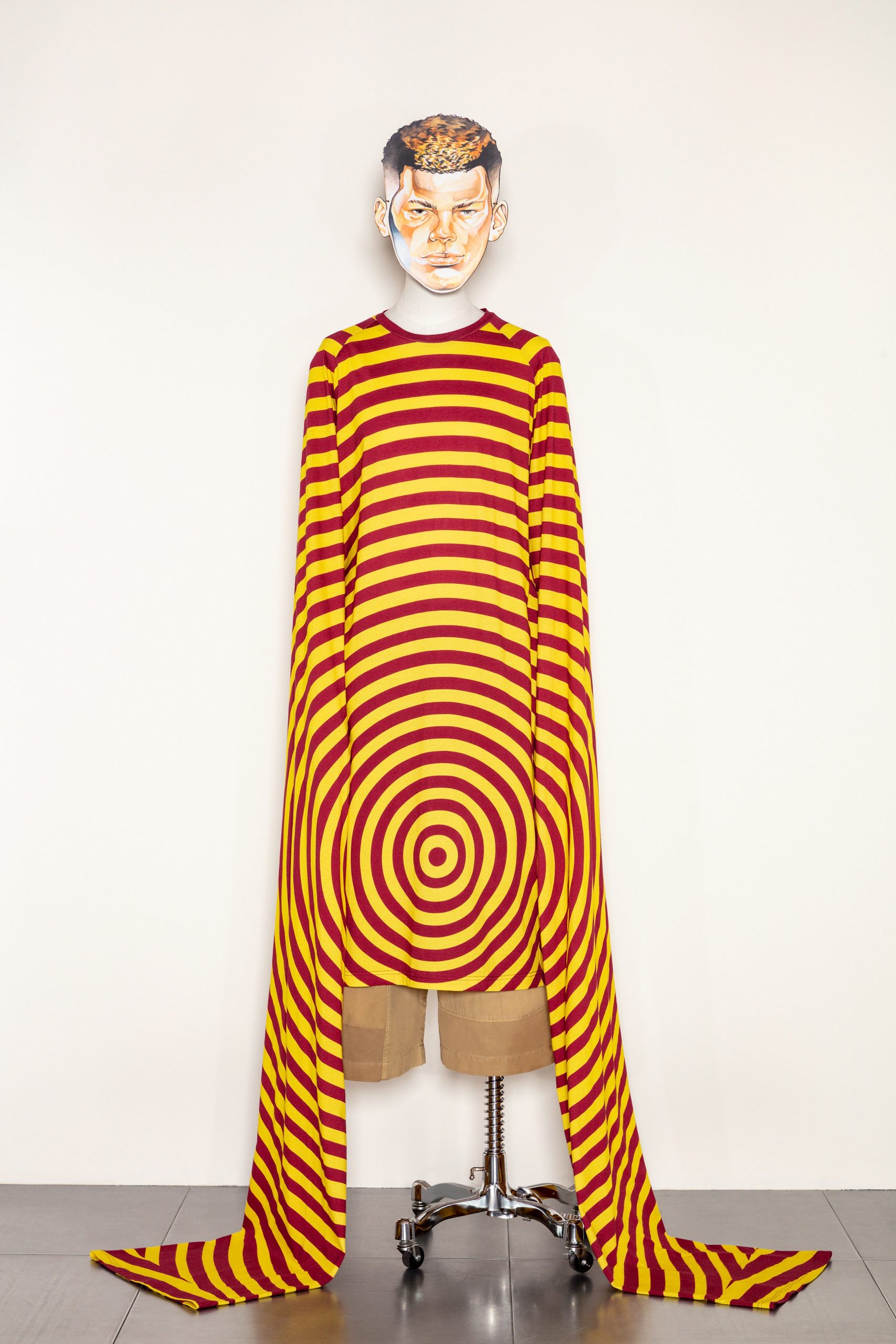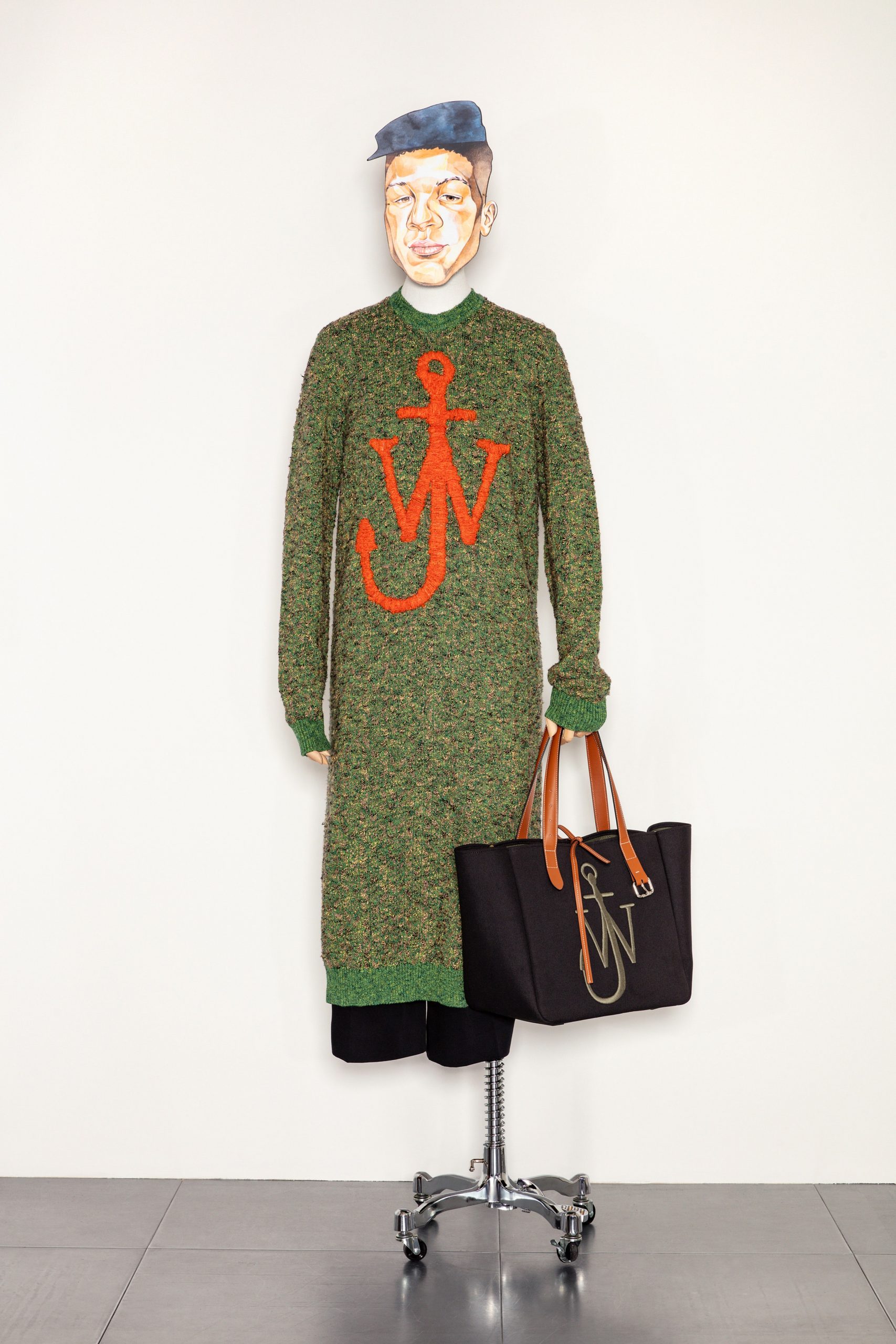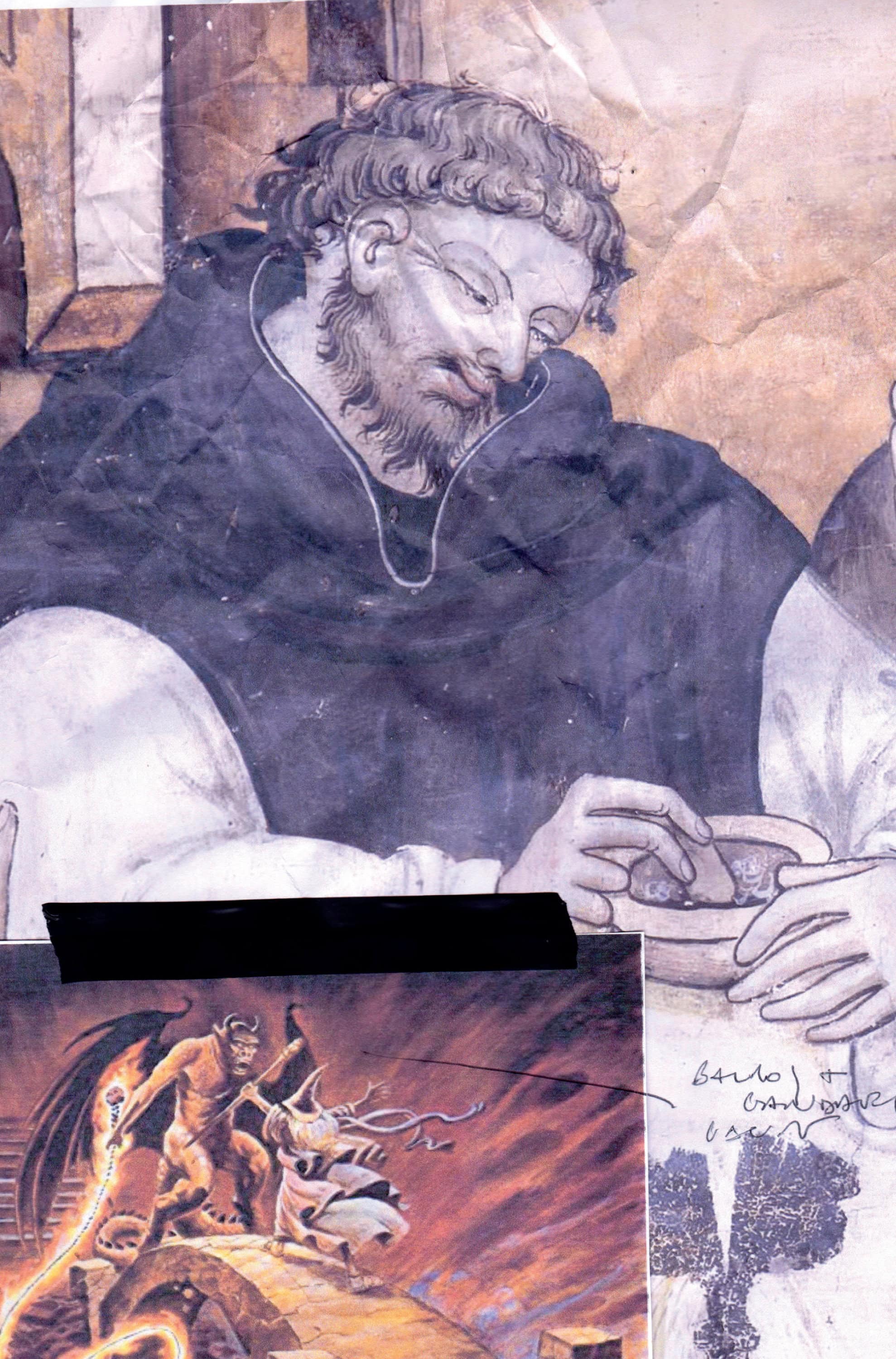Reviews of JW Anderson, Études, Louis Gabriel Nouchi, Woo Young Mi, Y/Project, Walter Van Beirendonck, Boramy Viguier & Berluti Spring 2021 Fashion Shows
Day 1 – Back to the Essence.
BY LONG NGUYEN
JW Anderson
Paris Men’s Spring-Summer 2021 had already started long before the official opening this morning, with the Hermès theatrical staging of a live performance of a simulation of an actual backstage show at the high-tech Pantin office building last Sunday. A few days before Hermès, JW Anderson sent a box wrapped in different printed cotton fabrics containing images and individual pages from a look book, plus drawings and printed handwritten note and details about the new collection, as well as a hand-drawn-and-cut-out masks by the artist Pol Anglada to give a face to the mannequins, perhaps as a way to impersonate a model who would have normally worn the imagined outfit in an actual show.
“The box you are unboxing is an undulating flow of textures, images, and formats arriving at one single goal: conveying a sense of optimism. You’ll decide where and when. The future is unwritten,” the designer wrote on a light pink and white striped paper, hoping that the personal touch would be an added charm to the impersonal online universe, in addition to providing an extensive human touch or a do-it-yourself kit for personal assembly “to experience in your own way.”
The new men’s offerings encompass the designer’s now recognizable signatures – an olive knit knee-length sweater (dress) and navy shorts, a flare khaki trench cape-jacket-hoodie combo made from collaged and patchworked old fabrics, an orange full-length print polo, a grey floral wallpaper print coat with giant black wool patch pockets, or gold yellow circular optical rings and extreme extra long flared sleeves. There is even a colorful hand-knit sailing patterned sweater that Anderson remade from the one his mother gave him, over a quarter of a century ago. Fabrics are mainly sourced from the leftovers, the unused, and the available in order to fabricate those patchwork garments.
The thing with Anderson’s work especially for his own menswear collection is his masterful and at times humorous alteration of the proportions of his garments, for example stretching to sleeves to impossible length and extending the collar to where it has never gone before. However bizarre these proportions may seem at first, the eyes eventually begin to adjust and the mind begins to accept these new parameters as part of the spectrum of clothes, rather than as oddities. And it may take a little bit of time for the wider public to adjust their vision, and accept these proportions as part of the staple like the look of a regular white tee-shirt.
Anderson understands that fashion depends on emotional responses, on how a person feels when looking at a show or at a specific product in stores and that this response is crucial in connecting with people, before they are audiences and raw data for the marketing department. Speaking from his London office, Anderson mentioned this cathartic moment but also a moment of forward momentum – “the idea of never compromising, the end is the beginning. We can reinvent ourselves. I think creativity is very important. In troubled times, it makes us reconnect with the idea of making, the idea of creative philosophy, and the idea of reinforcing what you believe in.”
Études
This first Paris show day of course started with the premier of a video!
The trio Aurélien Arbet, Jérémie Egry and José Lamali forming the collective Études commissioned Grégoire Dyer to make a short video for their 18th collection titled ‘YES FUTURE’ filmed entirely around the 20th arrondissement neighborhood close to their office with three different models taking solo walks, and taking over from each other at selected intersections of street corners, cafés, and staircases, forming a sort of continuous loop. The resulting film was a very effective way to show these clothes like the white large sliced sleeve coat with cinched back that one model wore at the start, to the black pants, blue short sleeve shirt, colored tee and tie-dyed jeans, striped cape shirt and white pants, a grey unstructured suit, and a brown silk striped loose shirt worn by the last model that truly fit into the environment of ordinary life, yet one set in the now trendy and fast-rising area of eastern Paris. As a brand destined for younger consumers and their values, the trio is focused on using as many eco-friendly fabrics as possible with little washing and machine dyes.
Separately the trio collaborated with the art photographer Roe Etheridge who shot images of the collection from a Paris studio and made collages for the final pictures in his home based in New York. Etheridge contributed his own art images that formed the print graphics on the short sleeve shirt, jersey hoodie, and oversize tee shown in the film.
Louis Gabriel Nouchi
An outstanding art-fashion presentation came from the young French designer Louis Gabriel Nouchi. Trained at École des arts visuels de la Cambre, Nouchi had worked briefly for Raf Simons before being invited to show in Paris in 2018 for the first time, after launching his own brand LGN the year before. Nouchi and the documentary filmmaker Keffer produced a short film featuring a series of people – all workers from various arts industries – each holding a copy of L’étranger, the 1942 novel by Albert Camus, and each begins reading from the first paragraph of the novel with one completing another’s sentences. It made for a compelling setting for showing great satin trenches, satin suits, a tank top and flowy pants, a silk tunic and loose pants, a slim safari suit, or a white cotton coat with fringed short sleeves.
“For this season, as in the previous one, the story is based on a book and I am concentrating on L’étranger by Albert Camus. It was interesting for me to work with this because it’s still very contemporary of all Albert Camus’ work, perhaps even more now. It is the occasion for me to talk about my own story, the world around me. All the emotions, the situations described in the book are a source of ideas inspired to create garments like the section at the end of the first part of the book showing strong and conflicting emotions. And colors like red that symbolize blood in the book.” Nouchi explained the connection between the words that evoked emotions in the book and the actual color of the garments in his collection, which also reflected the summer colors of Algeria. The artist Édouard Taufenback made some of the print by transferring archival photos of the city of Algiers into prints on shirts and pants. Theme, clothing, and video all seemed to work in conjunction to showcase LGN’s new summer wares, with just enough aura of intellect but not overwhelmingly so.
Woo Young Mi
“This year, around the world, we came together in a virtual dance of unity. Now we join hands and dance our way into the future, unified by the power of diversity, inclusivity, and hope. We are all connected,” said Woo Young Mi in introducing her summer collection. In the same way, the Korean designer Woo Young Mi’s dance performance filmed at the Théatre des Bouffes du nord in Paris where models moved effortlessly around a set of chairs in comfortable unisex outfits. The soft silhouette double-breasted jackets, trench coats, linear coats, shirt collar jackets all rendered in cotton khaki, black tropical and white wools, and black leather demonstrated the remarkable quality and ease that Woo Young Mi is known for in interpreting tailoring in all possible ways, at times causing a clashing of volumes within one garment.
Y/Project
“I fell in love with fashion fifteen years ago, during my first year at the Antwerp Academy. It was all about the beauty, the creativity, the preciousness, and the dream. In times of reflection, we are bound to question our essence. Versatility in wearability is a constant connection point between the different typologies of our garments. One design can be worn in different ways, creating a different emotion. We encourage our customers to question themselves. How do we feel? How do we want to be perceived? The garment is conceived to prolong each singular emotion. There is no correct answer,” said Glenn Martens of his straight-forward three-way instruction video on how to wear some of his clothes – clothes that are very cleverly designed and that often are trompe d’oeil for a combination of possible usage for one garment.
The video features a series of single models each with two dressers, who helped to transform their clothes from one garment into another. A black sweatshirt and pants with white trim can be opened with snaps at the sleeves and legs and then tied together to form a double sleeve and double legs. A black shirt and slim jeans become a sleeveless tee-shirt and a cut out tiered jeans. A black bandanna scarf can transform in an instant into a handy handbag. A seemingly simple black jean jacket and cigarette khaki pants can also can be a tucked-in double shirt and double pants. An uneven zig-zag sweatpant can be straightened and a wayward looking crooked nylon top is in fact just a nylon anorak. “Even the most basic Y/Project piece has a pronounced design twist,” Martens said of his design philosophy, pointing to the actual physical transformation of his clothes which often seemed puzzling on the runway but are now presented a clear and almost rudimentary manner.
Walter Van Beirendonck
It is sad not to see a Walter Van Beirendonck show as it has always been one of the most inventive shows in Paris every season since 1995, and this is not an easy accolade to bestow on any designer over such a long stretch. It is easy to understand the reason why by looking over the years at the audience and the ‘kids’ who waited outside to get a standing spot to see the show. ‘Mirror Ghosts Whisper Loud’ the title of the Van Beirendonck online film captured some of the designer’s new concepts for clothes, but a show would surely have translated his ethos far more effectively.
For this film, the designer named each of his mannequins with specific nomenclature to give the mannequin a little personality and a bit of glam rock vibes – Mirrorman wore a navy cut out patch pocket with mirror suit, The Magician had on an orange nylon parka with wool yellow jacket and green pants, Mr. Bold was paired with a dual-color parka vest, Mr. Thunderman had a faux fur green cape and zig-zag print shorts, and alas Mr. Spellbound wore a white cropped suit with faded color trims and a giant white faux fur coat. The Swiss artist Miriam Cahn contributed the prints and navy, brown, gold, and green palettes. “I designed and tailored the pieces that serve as protection from evil forces, symbolizing the oneness of humankind and representing the reawakening of beauty,” Van Beirendonck said of the sharply tailored jackets prominently featured on these mannequins accessorized with loop earrings.
“Wishing to counteract these turbulent times with a collection that is both hopeful and empowering, one that is future proof and rebirth ready, I also wanted to take a beat from the past,” said Van Beirendonck. He made 22 miniature dolls similar to those in the Dior Haute Couture film but without any of the efforts to render them in real-life sizes. Van Beirendonck pointed to the Théatre de la mode in 1945 as an inspiration and a way to react creatively to scarcity. But Van Beirendonck’s humor works best at some of the garages – his favorite show locations – around Paris. “Demand Beauty” the designer reminds all of us once again.
Boramy Viguier
“A pagan congregation of supreme spiritual beings, prophets on a quest for a better mindset, helped by an enigmatic strength and rigidity, humans with fantastic powers. Imagination and mind expansion are the only way to escape it,” said Boramy Viguier of his high tech and fast-paced video, with models zooming in and out against a silver cement concrete construction setting where the clothes played on elements of volumes and on mixing streetwear with some subtle religious, mystical, and surrealist iconography. Viguier completed the collection like almost everyone else with what he has and what he can easily find during confinement, such as recycled wool and old poplin cottons. Each product comes with its own tag and is unique due to the hand-screen-printed fabrics, and a tarot card is also included.
The setting of the daily pandemic by French government officials with the tricolor flags on each side and a hand signaling representative on the right-hand side of the screen – think BFM or France 1 evening news style, is transformed into a fantasy set that begins with a series of military parades along with marching martial music, and models in the center with descriptions of their outfits at the bottom like an awkward subtitle. The model is spun 360 degrees so the audience can see the entire look – ‘Black faux duster coat’ is a long coat worn with grey pants and felt hat, ‘recycled and embroidered navy pinstripe wool’ is a navy single-breasted jacket worn with a long charcoal tunic and red pants, and ‘black faux leather rodeo tailored jacket’ is a single-breasted jacket paired with black tuxedo pants.
Two strong looks are the beige wool sleeveless jacket with an ankle-length white shirt and black pants and a black taffeta cape coat with floral sleeves (one coat has bishop’s hoodie) – the looks imbued with old clerical dressing, just like a white nylon coat with an attached black cardinal cape.
“I want to find new perspectives, open my mind, and create a belief of my own. The demystified world likes to quantify everything – success through incomes, fame through followers. I am more willing to make collections that give a tragic sense of fantasy and spirituality,” said Viguier as he pondered how to proceed ahead into and out of the storm. The strong visual content of the video coupled with showing a solid collection is a great follow up for this the French designer, a 2019 LVMH finalist, who had his first show in Paris in January.
Berluti
Brian Rocheford is an artist living in Los Angeles who makes colorful ceramic sculptures that experiment with form, texture and surface finish. Rocheford also makes colorful patterns for prints for Kris Van Assche’s new Berluti collection. Together the artist and the designer had a zoom conversation about the origin of the work together. “When I first started with ceramics, I picked the most challenging colors which are red and orange. One of the things that I try to do in each piece is to get variation in color and texture,” said Rochefort as he is seen in his LA studio creating a new ceramic sculpture.
“It is totally related to what we do with patina on something very different, but I mean a brown is never just going to be a brown. A brown is an accumulation of 25 shades of brown,” interjects Van Assche of the first time he has done a collaboration since his arrival at Berluti two years ago – the years he learned and absorbed the brand’s DNA. Rochefort patterns and colors on his ceramics were photographed as still lives, then transfered onto computer prints, then transferred to silk for the shirts under a green or a light grey boxy double-breasted suit or a black sweatshirt with blue and green pattern print. Even the classic Berluti shoes got some new patterns using traditional handmade skills, a Berluti house know-how.
Epilogue
Missing from today’s lineup is Raf Simons who is known for his late-night shows on the outskirts of Paris. Instead, Simons is releasing a series of products chosen from past collections and has promised to reveal something new later in the fall. Simon’s art-centered shows have always provided relief from the excesses of commercial menswear.
At the conclusion of the first day of Paris Men’s online presentation, designers opted for a return to the source of their designs with the simple and direct approach visually, rather than any attempts at making too artsy films.
“But I will miss emotions, so as soon as we can go back to fashion shows and storytelling, I will definitely do that,” Van Assche said at the end of the video.
So do we.
